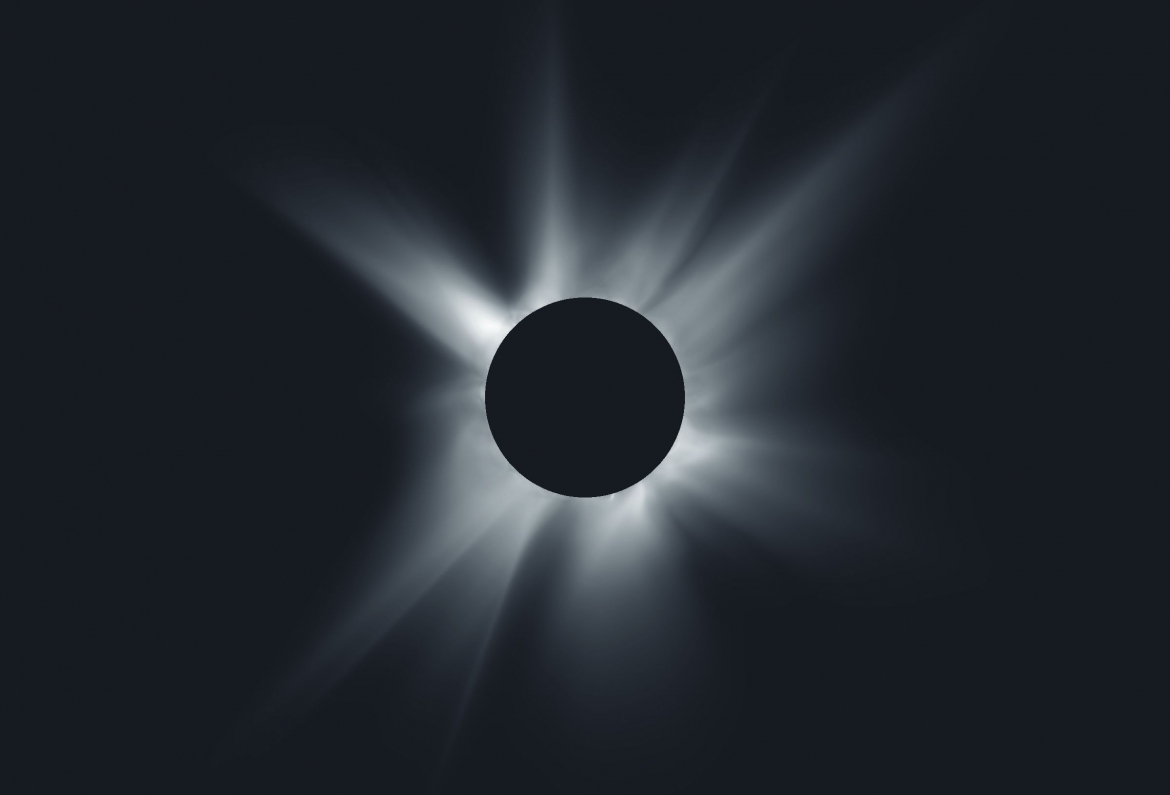8.04.2024

On April 8, a total solar eclipse will sweep across the continental United States — the first since 2017 and the last until Aug. 12, 2045. During totality, or the moment at which the Moon is completely covering the Sun, the Sun’s outer atmosphere, called the corona, and other prominences become visible to the naked eye. Scientists often use total solar eclipses as a chance to observe and study the Sun’s corona, and their results contribute to our understanding of stellar dynamics and solar storms and how they affect Earth.
In the months and weeks leading up to a total solar eclipse, scientists will often use supercomputers and other models to generate a model of what the Sun’s corona will look like during the eclipse. For the April 8 eclipse, scientists from Predictive Science used data from NASA’s Solar Dynamics Observatory (SDO) spacecraft to predict the structure of the Sun’s corona on April 8. Furthermore, to ensure that their model is up-to-date, the scientists also used NASA’s Electra Supercomputer, which actively updates the team’s model in real-time as new data from SDO is received.
The Sun’s corona is driven by heat and magnetic turbulence, which leads to the long strands of plasma that extend away from the Sun that can be seen during totality. However, these strands can extend much further out into space than we can see with the naked eye, creating “solar wind” that travels throughout the solar system, affecting different planets, moons, asteroids, and more.
When solar wind hits a planet’s atmosphere, energetic particles within magnetic fields around the planets react and produce a phenomenon known as aurora. Scientists often use the term “space weather” to describe the interactions between solar wind and planets’ atmospheres, as space weather events can vary from mild to severe, just like terrestrial weather that occurs within a planet’s atmosphere. In fact, some of the most extreme space weather events, like coronal mass ejections, can disrupt communications technology, affect astronauts and satellites in orbit, and even harm the electrical grids we use to power our everyday lives.
Scientists are often able to forecast space weather by regularly observing solar activity and conducting research on the Sun. The corona is perhaps the most important aspect of space weather and solar activity, which is why scientists take every chance they get to study it — during a total solar eclipse, for example.
“If you’re going to predict the path of a coronal mass ejection, just like for a hurricane, to have this more accurate background is really important,” said Predictive Science president Jon Linker.
While SDO and other solar observatories like NASA’s Parker Solar Probe and ESA’s Solar Orbiter provide vital insights into the inner workings of the Sun’s corona, scientists are still missing important information about the forces that drive the corona’s activity. Having this information would help scientists better predict the corona’s appearance and activity, subsequently improving space weather forecasts.
“We don’t have a way of measuring the magnetic field accurately in the corona. That’s one of the things that makes this so challenging,” said research scientist Emily Mason of Predictive Science.

Predictive Science’s coronal prediction for the 2017 total solar eclipse (right) and an image of the Sun’s actual corona during totality (left). (Credit: Predictive Science Inc./Miloslav Druckmüller/Peter Aniol/Shadia Habbal)
When building their model of the corona on April 8, the team of scientists used measurements of the changing magnetic field at the Sun’s surface to drive their corona model in near real-time. In order to do this, the team created an automated process that converted raw SDO data into data that showed how magnetic flux and energy are directly injected into the corona over time. Including this data in their model allowed scientists to model how the corona evolves over time and creates solar eruptions.
“We developed a software pipeline that took in the magnetic field maps, picked out all of the areas that should be energized, and then fine-tuned the amount of energy to add to those areas,” Mason said
Creating this automated data pipeline was a huge innovation for the team and corona prediction models. For past model development, teams had to use static snapshots of the surface magnetic field, meaning that models couldn’t account for the ever-changing dynamics of the Sun’s intense magnetic field and coronal activity — not ideal for the current period of heightened solar activity. What’s more, scientists previously had to hand draw areas around the Sun that needed to be energized by analyzing ultraviolet activity around the Sun in certain regions.
The April 8 eclipse is the first time this new data pipeline and model will be used to predict the corona during an eclipse. With total solar eclipses occurring once or twice every one to two years, the team will continue to update their models and data pipelines to ensure their models are as accurate as possible.
“We’ve used the eclipse predictions every time to do something new with the model. I’m really excited to see over the next two weeks how this prediction keeps improving. I think it will be a really drastic difference from what we used to be able to do,” said research scientist Cooper Downs of Predictive Science, who led the development of the automated modeling/data pipeline.
“The eclipse is just such a fantastic chance to go, ‘Look at this! This is what we think it’s going to look like! Don’t you want to learn more about this?’ It’s a really exciting opportunity for us to share the things that excite us all year round with everybody else,” Mason said.
(Lead image: Prediction of the Sun’s corona at totality in Dallas, Texas, on April 8. Credit: Predictive Science)
Quelle: NSF

